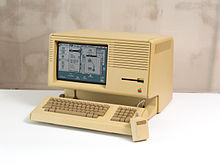 A Macintosh XL | |
| Manufacturer | Apple Computer |
|---|---|
| Release date | January 1, 1985 |
| Introductory price | US$3,995 (equivalent to $11,320 in 2023) |
| Discontinued | April 29, 1985 [1] |
| Operating system |
MacWorks XL / System
1.1,
[2]
2.0,
2.1,
3.0,
3.2; MacWorks Plus / System 1.1– 6.0.3; MacWorks Plus II / System 1.1– 6.0.8, 7.0– 7.5.5 |
| CPU | Motorola 68000 @ 5 MHz |
| Memory | 512 KB RAM (the Lisa DRAM card), expandable to 2 MB |
| Predecessor |
Apple Lisa Macintosh 512K |
| Successor | Macintosh Plus |
Macintosh XL is a modified version of the Apple Lisa personal computer made by Apple Computer. In the Macintosh XL configuration, the computer shipped with MacWorks XL, a Lisa program that allowed 64 K Macintosh ROM emulation. An identical machine was previously sold as Lisa 2/10 with the Lisa OS only.
Hardware
Macintosh XL has a 400K 3.5" floppy drive and an internal 10 MB proprietary "Widget" hard drive [3] with provision for an optional 5 or 10 MB external ProFile hard drive with the addition of a parallel interface card. The machine uses a Motorola 68000 CPU, clocked at 5 MHz together with 512 KB RAM. Macintosh XL was discontinued in April 1985. [1]
Upgrades
Because of its roots as a Lisa — unlike all other Macintosh computers — the stock Macintosh XL used rectangular pixels. The resolution of Macintosh XL's 12-inch (30.5 cm) display was 720×364 pixels. Square pixels were available through the Macintosh XL Screen Kit upgrade that changed the resolution to 608×432 pixels. [4] The CPU could be replaced with a new CPU board containing up to 8 MB RAM, called XLerator 18. [5] The maximum upgraded RAM with conventional add-in RAM cards was up to 2 MB – quadruple the maximum capacity of earlier Macintosh computers. With modifications to the CPU board, the XL could accommodate up to 4 MB of RAM. [6]
MacWorks
MacWorks Plus was developed by Sun Remarketing as a successor to MacWorks XL in order to provide application compatibility with the Macintosh Plus computer. MacWorks Plus added support for an 800 KB 3.5" floppy disk and System software up through version 6.0.3. MacWorks Plus II extended that to the same System 7.5.5 limit imposed on all 68000 processors. [7]
History
This section needs additional citations for
verification. (April 2023) |
After two years of lackluster sales, Apple attempted to salvage Lisa by redesigning some hardware components and renaming it as Macintosh XL. Basing on the previous sale figures of Lisa, Apple ordered the limited number of parts as to last through 1985 before ending the production. The redesign spurred a record number of orders for this addition to the Macintosh line, which caught Apple off-guard. [8]
Discontinuation
Due to the limited number of parts ordered, Apple had sold its entire allocations of Macintosh XL for 1985 much earlier than anticipated. Had Apple continued to manufacture Macintosh XL as to meet the demand at lower price, the company would have lost even more money on each unit. Additionally, the cancellation was also due to the necessary consolidation of expenses and projects. [8] [9] In 1986, Apple offered an exchange program for the owners of Lisa and Macintosh XL: The owners could exchange their Lisa and Macintosh XL along with $1,495 US for the new Macintosh Plus and Hard Disk 20 (list price of $4,098 US). [10]
Sun Remarketing
After Apple dropped the XL from their price list in September 1985, Sun Remarketing of Logan, Utah, bought a number of Apple's remaining inventory and continued to sell them under license with their updated version of MacWorks Plus, re-branding it as Macintosh Professional.
Although no new Lisas were available for sale, development continued on MacWorks Plus to support the installed base of Lisas, making them as relevant as their closely related cousin Macintosh Plus.
Legacy
Macintosh XL shares the same legacy as Lisa before it. However, the increased sales from the emulation of the Macintosh operating system proved that the Macintosh family badly needed a more professional environment which could support larger monitors, greater memory, and more expandability than Macintosh 512K offered.
Timeline
| Timeline of Compact Macintosh models |
|---|
 |
Timeline of Lisa models

See also
References
- ^ a b Linzmayer, Owen W. (2004). Apple Confidential 2.0: The Definitive History of the World's Most Colorful Company. p. 80. ISBN 9781593270100. Archived from the original on April 23, 2022. Retrieved January 2, 2014.
- ^ "System Software: Configs for Mac 128K, XL, 512, & 512KE (7/94)". Apple Computer. February 18, 2012. Archived from the original on August 20, 2012.
- ^ Linzmayer 2004, p. 79
- ^ Pina, Larry (1991). Macintosh Repair & Upgrade Secrets. Hayden Books. p. 274. ISBN 0672484528.
- ^ XLerator 18 "XLerator" Archived December 3, 2013, at the Wayback Machine
- ^ Pina 1991, p. 273.
- ^ "MacWorks Plus II". Archived from the original on February 8, 2008. Retrieved January 21, 2008.
- ^ a b "Apple's Lisa Meets a Bad End". InfoWorld. Vol. 7, no. 22. June 3, 1985. p. 21. ISSN 0199-6649. Retrieved September 18, 2021.
- ^ Chernoff, Paul (1988). "Book Review: AppleDesign and Apple: The Inside Story". Washington Apple Pi Journal. Archived from the original on August 22, 2017. Retrieved September 18, 2021.
- ^ "Semaphore Signal 26". Semaphore Corporation. March 1986. Archived from the original on September 24, 2015. Retrieved September 18, 2021.